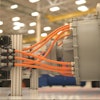ALBANY, N.Y. (AP) -- The federal law that can force companies to spend millions cleaning up contaminated sites has again been upheld by a judge, who ruled that the Environmental Protection Agency can force General Electric Co. to dredge PCBs from New York's Hudson River.
GE sued in 2000, just before the EPA ordered the company to pay for dredging contaminated sediments along a 40-mile stretch of river north of Albany. Its plants released about 1.3 million pounds of PCBs, or polychlorinated biphenyls, into the river between 1946 and 1977, the year the federal government banned the substance.
A 197-mile section of the river has since been declared a Superfund site.
In its lawsuit, the company challenged the EPA's unilateral authority to order cleanup projects under the Comprehensive Environmental Response, Compensation and Liability Act, also known as Superfund.
GE's lawyers argued that the agency's ability to order such cleanups in non-emergency situations violates the due process clause of the U.S. Constitution's Fifth Amendment.
In a ruling issued Tuesday, U.S. District Court Judge John Bates upheld the Superfund law's constitutionality, saying he "rejects GE's novel, but substantial, challenge."
It was the second time Bates reviewed the case, and the second time he rejected GE's challenge.
Bates initially ruled in 2003 that Congress intended for cleanup of toxic sites to proceed without delay by even a constitutional challenge. GE appealed that ruling, and the appeals court judge sent it back to Bates.
"We're still reviewing the decision and will consider all our options, including the right to appeal as we review the complex decision," said Peter O'Toole, a GE spokesman.
Andrew Ames, a Justice Department spokesman, said GE could appeal to the Circuit Court in Washington. He declined to comment on the judge's ruling.
"The opinion speaks for itself," Ames said.
Environmentalists lauded the judge's decision.
"This is a significant victory for the environment and public health," said Lawrence Levine, an attorney for the Natural Resources Defense Council, which filed friend of the court briefs in the case.
"It preserves EPA's ability to direct polluters to immediately clean up hazardous waste sites they're responsible for," Levine said. "That carries out the will of Congress when it passed the Superfund law."
New York first took steps to clean up the mess in the mid '70s but local opposition, legal fights, studies and bureaucratic wrangling have dragged the case out. GE spent years arguing that dredging would be disruptive and scientifically unsound. The company dropped public opposition after the EPA signed a dredging order in 2002 but legal issues and negotiations pushed back the start date several times.
The Superfund law was created in 1980 after the toxic pollution of the Love Canal, a residential community outside of Niagara Falls that was built on top of a canal used as a dumping ground by the Hooker Chemical Co. At least six courts have thrown out constitutional challenges to it.
The EPA considers the PCBs in the Hudson to be a probable carcinogen and a risk to people who eat fish from the river.
O'Toole said the total cost of the dredging is estimated at $690 million. GE this spring will start removing 1.8 million cubic yards of contaminated sediment from the river, which will be dried and shipped to a Texas landfill, he said.
Associated Press writer Mary Esch contributed to this report from Albany, N.Y.






















